I still remember the day I brought my first puppy home. The overwhelming mix of pure joy and the sudden, heart-pounding panic of “what do I do now?” is a feeling I’ll never forget. As a certified trainer, I’ve seen that same look on the faces of so many new puppy parents.
You’re excited, but you’re also looking for a clear plan. A predictable puppy schedule is the single most important tool for a peaceful home and a confident, well-behaved dog. This guide will give you a simple, flexible, and positive routine to set you both up for a lifetime of success.
Smarter Paws Academy is reader-supported. When you buy through links on our site, we may earn an affiliate commission at no extra cost to you. As an Amazon Associate, I earn from qualifying purchases. Thank you for your support!
Important Health Disclaimer
The information in this article is for educational purposes only. It is not a substitute for professional veterinary advice. Please consult your veterinarian for any health concerns regarding your new puppy.
Quick Tips for Your Puppy’s Schedule
- Frequent Potty Breaks: A young puppy needs to go out every 1-2 hours, immediately after waking up, after playing, and after eating.
- Enforced Naps are Key: Puppies need 18-20 hours of sleep a day. A “one hour out, two hours in” crate schedule prevents them from becoming overtired and cranky.
- Consistency Over Rigidity: The goal is a predictable routine, not a strict military-style schedule. Be consistent with the sequence of events, but flexible with the exact times.
Prefer to Listen? An Audio Overview
For a conversational deep dive into this topic, press play below for the complete audio discussion.
Runtime: 1 minute 58 seconds
View Full Audio Transcript
Narrator: Welcome to the Smarter Paws Academy audio overview. Today, Sandie is breaking down one of the most requested topics for new owners: the perfect puppy schedule. Sandie, what’s the single biggest mistake new owners make?
Sandie Calloway: Thanks for having me. The biggest mistake is giving a new puppy too much freedom, too soon. This leads to potty accidents and chewed-up furniture. The key to success is a predictable routine built around a simple rhythm: about one hour of supervised activity, followed by two hours of quiet nap time in their crate. This prevents a puppy from getting overtired, which is the number one cause of cranky, bitey behavior.
Narrator: So that ‘one hour out, two hours in’ cycle is really the foundation. What are the non-negotiable events that must happen during that “hour out”?
Sandie Calloway: There are four pillars. First, potty breaks. Take them out immediately after every nap, every meal, and every play session, without fail. Second, consistent feeding times to regulate their digestive system. Third, make the crate a wonderful place with special toys to build a positive association. And fourth, short, fun sessions of play and socialization to build a confident, happy dog.
Narrator: What about for parents who work? How can they manage a schedule like this?
Sandie Calloway: It’s definitely a challenge, but it’s doable. A puppy playpen is a lifesaver for creating a safe, larger space for when you’re gone. The most critical thing is arranging for a midday potty break, whether you come home for lunch or have a trusted friend or dog walker stop by. That one break can make all the difference in successful potty training.
Narrator: That’s incredibly helpful advice. So a consistent schedule really is the secret weapon.
Sandie Calloway: Exactly. It’s not about being rigid; it’s about being predictable. A good schedule tells your puppy what to expect from their day, which reduces anxiety and helps them learn the rules of your home so much faster. It’s the foundation for a peaceful life together.
Table of Contents
What is an Ideal Puppy Schedule?
An ideal puppy schedule is a predictable routine of potty breaks, feeding, playtime, training, and sleep that meets a young puppy’s physical and mental needs. The goal is structure, not rigidity. Consistency is what helps your puppy learn the rules of the house, master potty training, and feel secure in their new environment.
For young puppies (8-12 weeks), the most important “rule” I teach my clients is the ‘One Hour Out, Two Hours In’ cycle. This means for every one hour of supervised activity (playing, training, exploring), your puppy needs about two hours of quiet nap time in their crate. This simple rhythm prevents them from becoming overtired, which is a major cause of puppy biting and destructive behavior.
Sample Puppy Schedule for an 8-12 Week Old (Printable Chart)
Every puppy is different, but this sample schedule is a fantastic starting point. You can adjust the times to fit your own routine, but try to keep the sequence of events consistent. This predictability is what your puppy craves.
| Time | Activity | Notes |
|---|---|---|
| 7:00 AM | Wake Up & Potty Break | Take your puppy out immediately. No playing first! |
| 7:15 AM | Breakfast | Feed your puppy their first meal in their crate. |
| 7:30 AM | Potty Break | Another trip outside right after eating. |
| 7:45 AM | Playtime & Training | 15-20 minutes of supervised play or a short, fun training session. |
| 8:30 AM | Crate / Nap Time | Time for a nap. Give a special crate-only chew toy. |
| 10:30 AM | Potty Break | Take them out as soon as they wake up. |
| 12:00 PM | Lunch & Potty Break | Second meal of the day, followed by a trip outside. |
| 12:30 PM | Quiet Time & Nap | Another scheduled nap in their crate. |
| 2:30 PM | Potty Break & Play | Wake up, go outside, and have some supervised fun. |
| 4:00 PM | Nap Time | A final afternoon nap. |
| 5:00 PM | Dinner & Potty Break | Last meal of the day, followed by a potty break. |
| 5:30 PM | Evening Play & Family Time | Supervised time with the family. |
| 7:00 PM | “Calm Down” Time | Start winding down. No more rough play. |
| 8:30 PM | Last Potty Break | Final trip outside before bed. |
| 9:00 PM | Bedtime in Crate | Time for sleep. |
Key Components of a Successful Puppy Schedule
Potty Breaks: How Often Should You Take Your Puppy Out?
The golden rule for potty training is “more is more.” A young puppy’s bladder is tiny. A good general guideline is that they can “hold it” for their age in months plus one. So, a 3-month-old puppy can theoretically hold it for about four hours, but you should be taking them out much more frequently to prevent accidents. For a brand new puppy, I recommend a potty break at least every two hours during the day.
Crate Training: Creating a Safe & Peaceful Haven
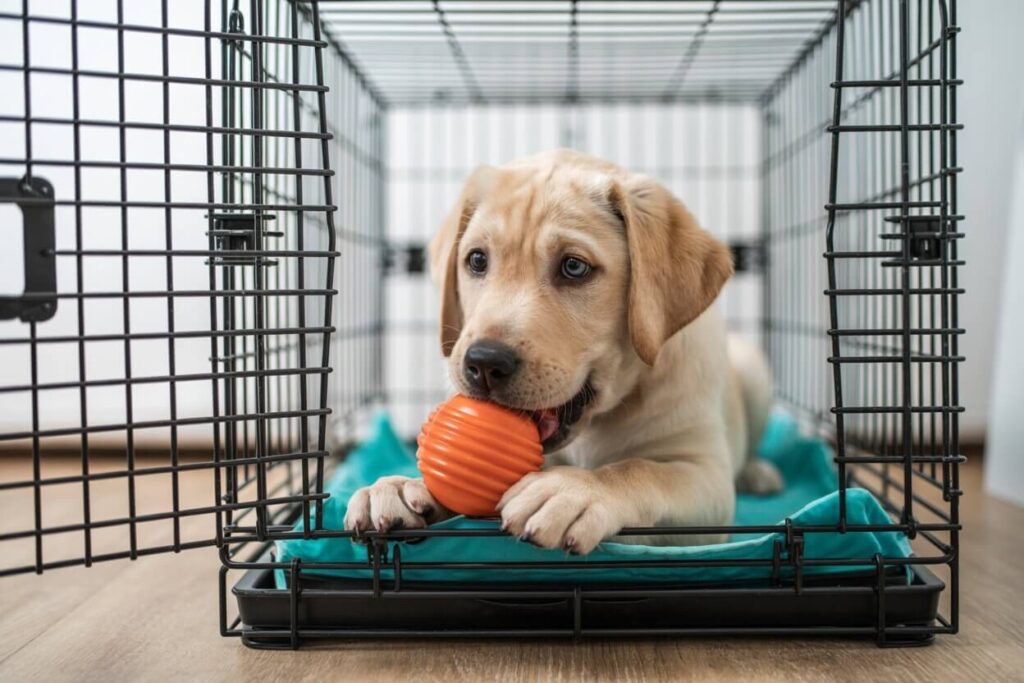
A crate is not a punishment; it’s your puppy’s personal den. As veterinary experts at UC Davis explain, dogs naturally seek out dens for security. By making the crate a wonderful place with special toys and treats, you teach your puppy to love their quiet time. This is essential for preventing separation anxiety and for a peaceful night’s sleep. (For a more detailed guide, see our step-by-step plan for stopping puppy barking in the crate.)
Feeding Times: How Many Meals a Day?
Young puppies (under 6 months) have fast metabolisms and need to eat more frequently. Most puppies start on three meals a day. You can typically switch a puppy from 3 meals to 2 at around six months of age, but always consult your veterinarian about the best plan for your specific breed and size.
Playtime & Socialization: Building a Confident Dog
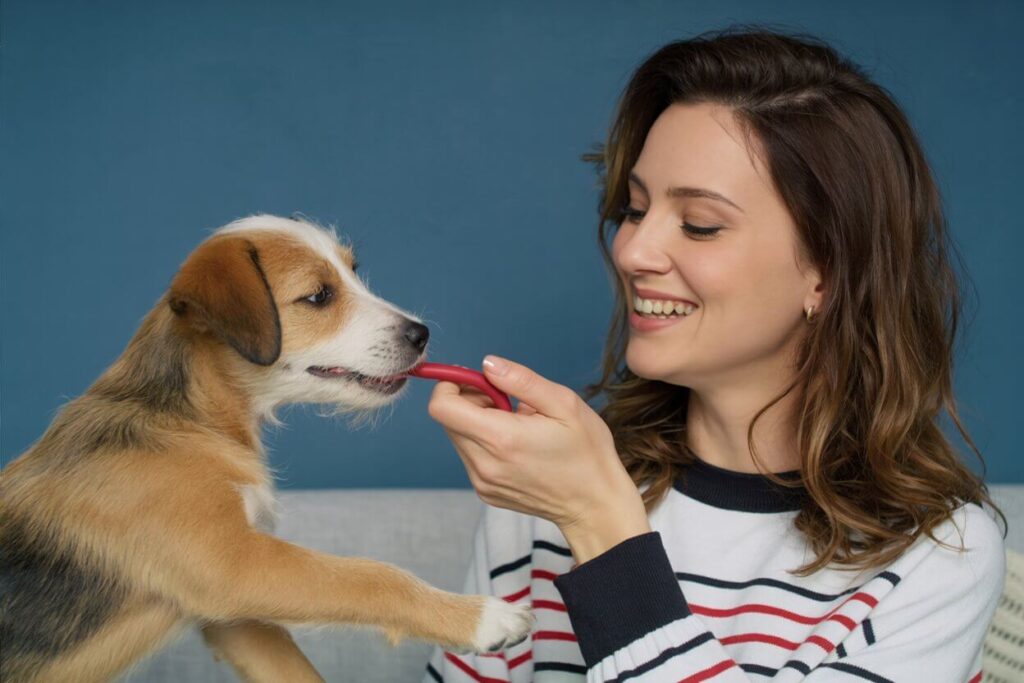
Playtime is not just about burning energy; it’s about learning and bonding. Use this time for short, fun training games and gentle exposure to new sights and sounds. The critical socialization window, as explained by experts, is between 3 and 14 weeks. This is the prime time to create positive associations that will last a lifetime. (Learn more about how to manage puppy nipping in our comprehensive guide to bite inhibition.)
Essential Supplies for Your Puppy’s Schedule
Having the right tools makes sticking to a schedule so much easier. Here are a few items I recommend to all my new puppy clients.
A Properly Sized Crate
Why it’s essential: This crate includes a crucial divider panel that allows you to adjust the living space as your puppy grows. This is the key to successful potty training, as it prevents accidents in an oversized area and creates a safe, den-like space.
A Puppy Playpen / Gate
Why it’s a lifesaver: For times when you can’t directly supervise, a playpen or gate creates a safe, puppy-proofed zone. This is a must-have for working parents, preventing destructive behavior and giving your puppy a secure space to relax.
An Enrichment Toy
Why it’s a game-changer: Made with softer rubber for puppy teeth, this toy can be stuffed with food to make crate time a positive and fun experience. It’s a powerful tool for preventing crate anxiety and redirecting puppy energy.
High-Value Training Treats
Why they work: These small, soft treats are perfect for the frequent rewards needed in a puppy’s schedule. They are made with real ingredients and are low-calorie, making them ideal for potty training rewards and short, positive obedience sessions.
An Enzymatic Cleaner
Why it’s non-negotiable: Accidents will happen. An enzymatic cleaner doesn’t just cover up the smell; it destroys the odor molecules at the source. This is critical for preventing your puppy from being attracted to and re-soiling the same spot.
What About Schedules for Working Parents?
Sticking to a puppy schedule when you work full-time can be a challenge, but it’s absolutely possible. The key is to maximize the time you do have and create a safe setup for when you’re away. A puppy playpen or a puppy-proofed room is essential for longer absences. If possible, arranging for a midday potty break—either by coming home for lunch or hiring a trusted dog walker—is a game-changer for potty training success.
Frequently Asked Questions
What is the “rule of 3” for a new puppy?
The “Rule of 3” is a helpful guideline for setting expectations. It suggests it takes about 3 days for a puppy to decompress, 3 weeks for them to start learning your routine, and 3 months for them to start feeling truly at home. It’s a great reminder to be patient!
Should I wake my puppy up to pee during the night?
For the first week or two, yes. For an 8-week-old puppy, setting an alarm for one or two potty breaks during the night can prevent accidents and teach them to hold it. As they get older, you can gradually extend the time between breaks.
How long after eating does a puppy usually poop?
Most puppies need to poop within 5 to 30 minutes after eating. This is why a post-meal potty break is a non-negotiable part of the schedule and a key to successful house training, as confirmed by the ASPCA.
What is the hardest week of having a new puppy?
Many owners find the first week to be the hardest due to sleep deprivation and the shock of the new routine. Another challenging period is often around 4-6 months when teething is at its peak. Remember that it’s normal to feel overwhelmed, and it will get better!
What if I regret getting a puppy?
This is a very common but rarely discussed feeling called the “puppy blues.” The sudden, dramatic life change can be overwhelming. Be kind to yourself, stick to the schedule (it helps you as much as the puppy), and don’t be afraid to ask for help from friends, family, or a professional trainer. This feeling almost always passes as you and your puppy build your bond.
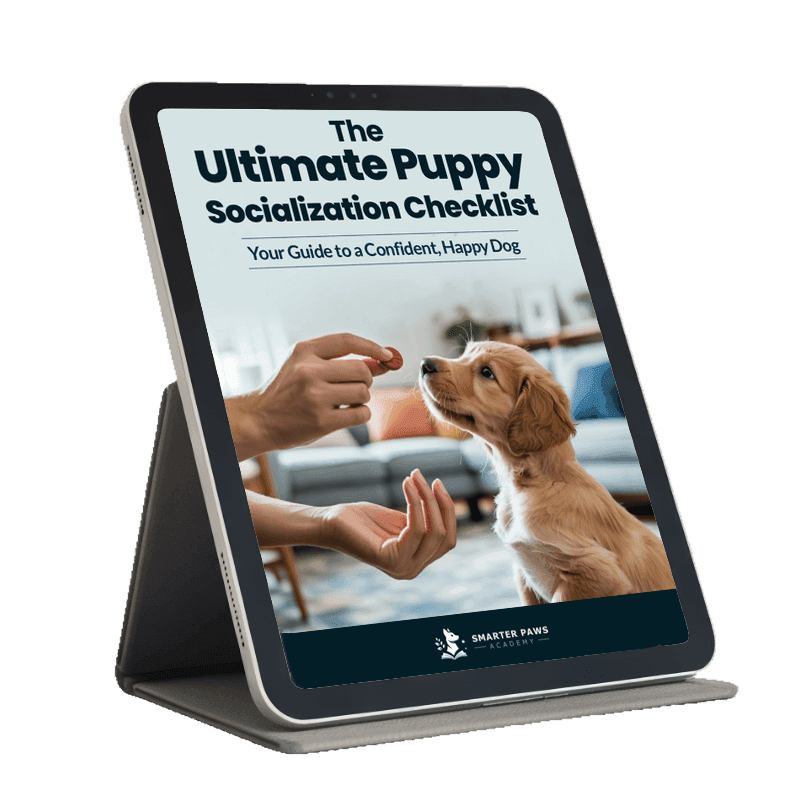
Give Your Puppy the Best Start in Life
Don’t leave socialization to chance. Get our free, certified trainer-approved checklist for a step-by-step guide to raising a confident, happy dog.
Creating Predictability, Building Confidence
Remember, a puppy schedule is not about being a rigid drill sergeant; it’s about being a loving and predictable leader. This consistent routine is your single greatest tool for successful potty training, peaceful nights, and preventing problem behaviors before they start. By providing this structure, you are giving your puppy the incredible gift of security, helping them understand their new world and confidently grow into the well-behaved companion you’ve always dreamed of.

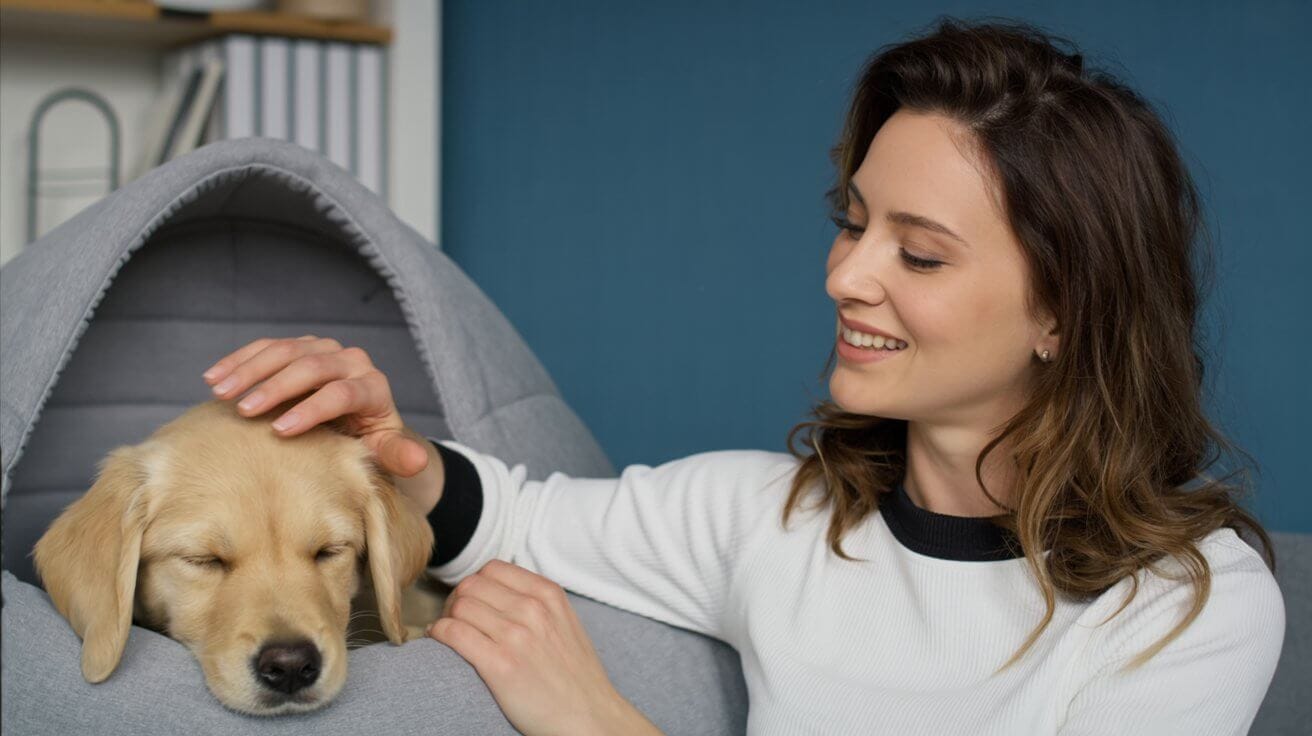





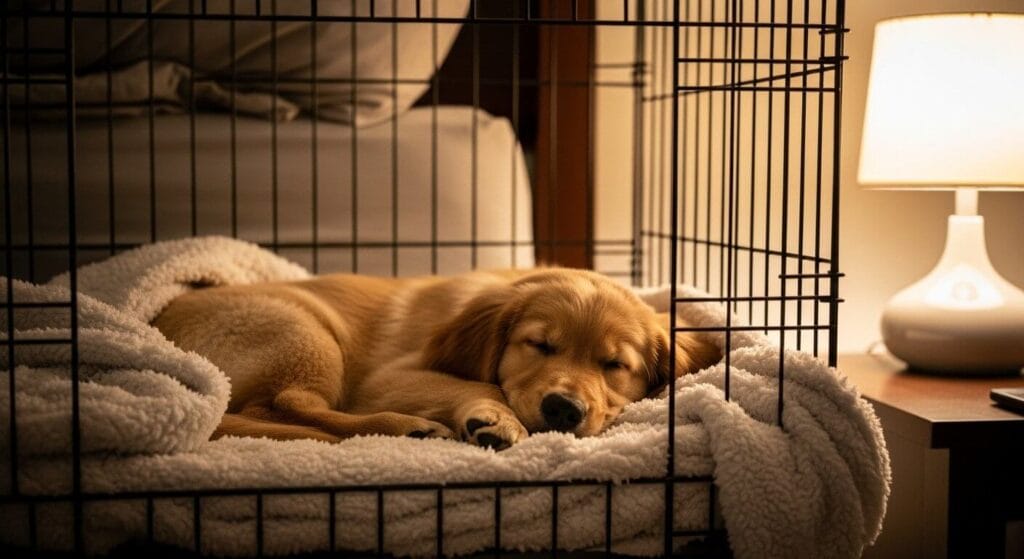
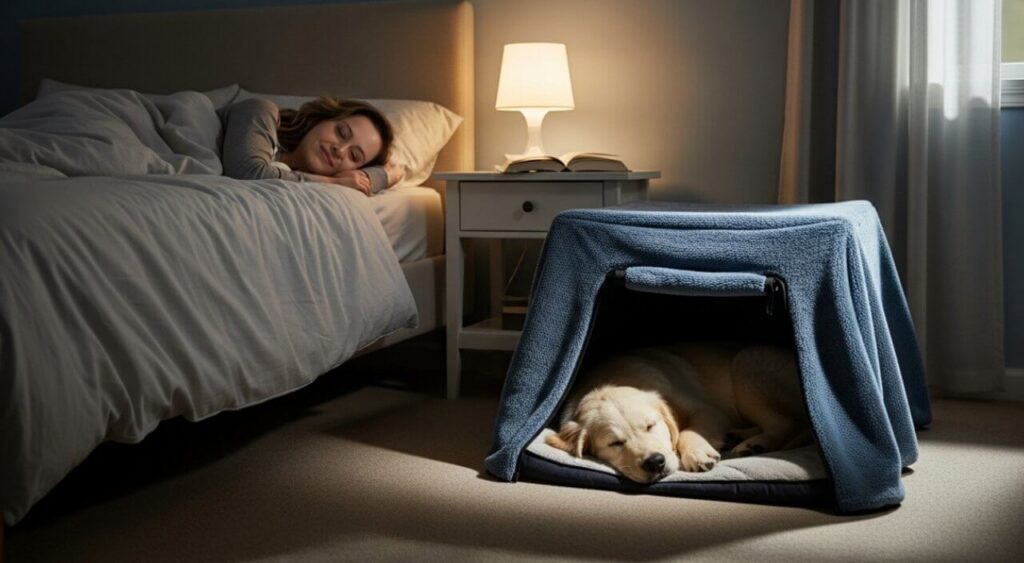
Great information!